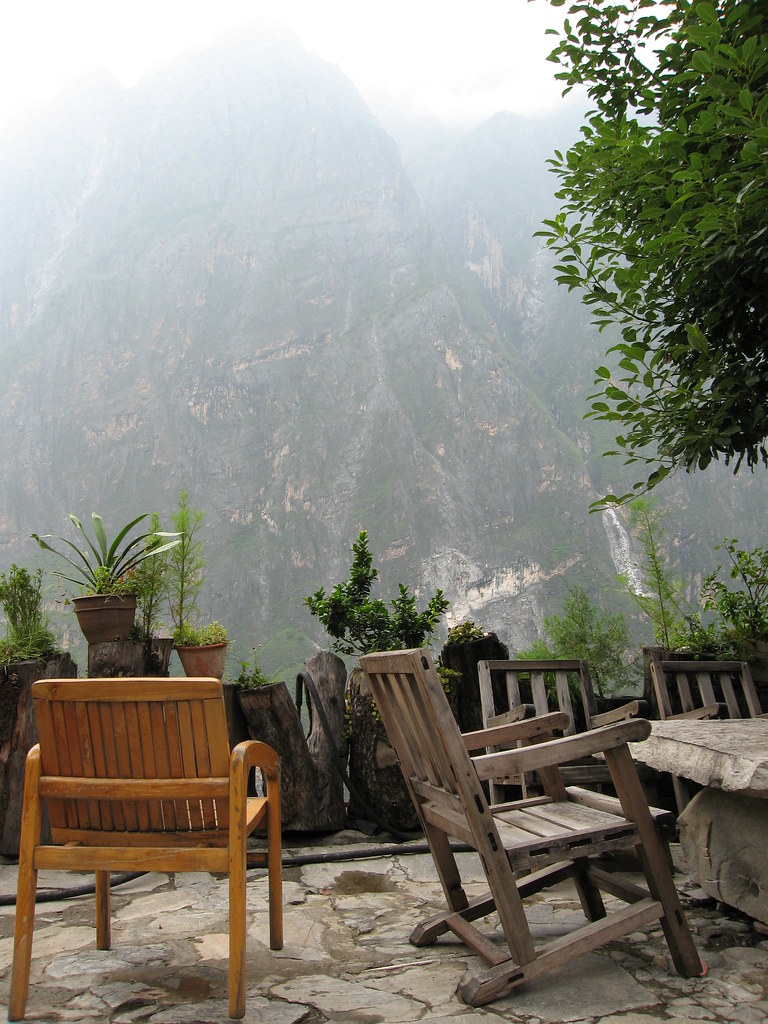Type your summary here okokf
Type rest of the post here indeed
Friday, August 31, 2007
Thursday, August 30, 2007
test
rrrrr rrrrrrrrrrrrrrrrrr rrrrrrrrrrrrrrr rrrrrrrrrrrrryyyyyyyyyyyyyy yyyyyyyyyyyy yyyyyyyyyyyyyy
Read more...China's Wild (Sth) West...
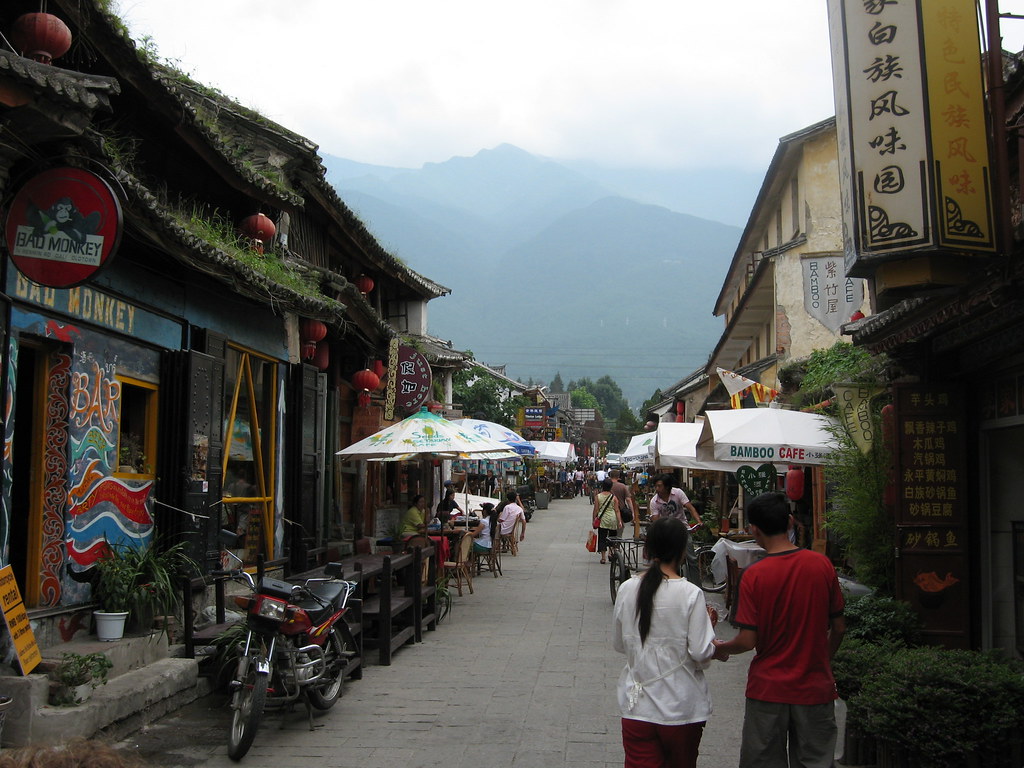
Our first stop was Dali an ancient city that has undergone extensive restoration. Flanked by a mountain, and surrounded by high city walls and a moat this city is a mecca for Chinese tourists. We spent quite a bit of time watching all the ridiculous photo opportunities that people were taking outside the city walls amidst downpours of rain. As a major tourist destination there were no shortage of restaurants to cater for demand. One thing that has shocked us is that since we were here eight months ago the price of meat has risen by a whopping 45%. Luckily we saw this fact on TV otherwise we'd still believe that people were trying to rip us off. Unfortunately we left Dali before realising that one of the most famous "chinglish" signs lived there, it's a famous sign over a squat toilet that simply reads "No shitting in the toilet". Moving north in the full brunt of the region's wet season we reached the picturesque city of Lijiang. Despairingly we reached the labyrinth of the old town as darkness was falling and when there wasn't much room at any of the inns. Arriving under such conditions is always the worst part about backpacking, particularly when the bags are getting heavier and wetter. Adding to the stress were armies of tiny Chinese tourists barging around with umbrellas held at a dangerously eye gouging height - well for me anyhow. Whenever they tried to pass Marcus they bizarrely would attempt to raise their umbrella over and above his! The following morning bathed in sunshine, Lijiang looked a lot more appealing - although the peril of the sun umbrella was still threatening. We managed to find a perfect little traditional Naxi courtyard guesthouse complete with a friendly pregnant owner who when asked when the baby was due replied "it's coming in two days".
The old narrow streets of Lijiang are lined with small waterways and little bridges making it a quirky little place with lots of character. The local ethnic minority in the region is the Naxi people and their Dongba religion and culture, of Tibetan origin, is an important part of the music, paintings and lives of the people. Lijiang is also an extremely popular destination for rich domestic tourists; after dark the bars and restaurants are full of this breed favouring expensive imported Heineken in place of their cheaper local brew. The rowdiness and noise level gradually elevates as rival bars compete in "sing offs" across the canals. Literally one bunch of girls trying to out-sing the other, what's more is that it appears to be the same song that they sing all night, every night.
 Our next stop was a 2 day hike through Tiger Leaping Gorge, allegedly the deepest gorge in the world. Again, it's a heavily visited spot but thankfully the bus tourists are all confined to the bottom of the gorge close to the river (and near the bus parking lot). The hiking trail wanders high up the gorge along a tranquil scenic route far away from the hustle and bustle below. Hiking the gorge is relatively straightforward, you leave any big luggage under lock and key at the start of the hike and take off with a small bag, some water and a map. There are guesthouses dotted along the trail and red arrows mark the way. In total the trek takes about 8 hours. Most people complete it in an easy two day outing leaving lots of time to enjoy the scenery.
Our next stop was a 2 day hike through Tiger Leaping Gorge, allegedly the deepest gorge in the world. Again, it's a heavily visited spot but thankfully the bus tourists are all confined to the bottom of the gorge close to the river (and near the bus parking lot). The hiking trail wanders high up the gorge along a tranquil scenic route far away from the hustle and bustle below. Hiking the gorge is relatively straightforward, you leave any big luggage under lock and key at the start of the hike and take off with a small bag, some water and a map. There are guesthouses dotted along the trail and red arrows mark the way. In total the trek takes about 8 hours. Most people complete it in an easy two day outing leaving lots of time to enjoy the scenery.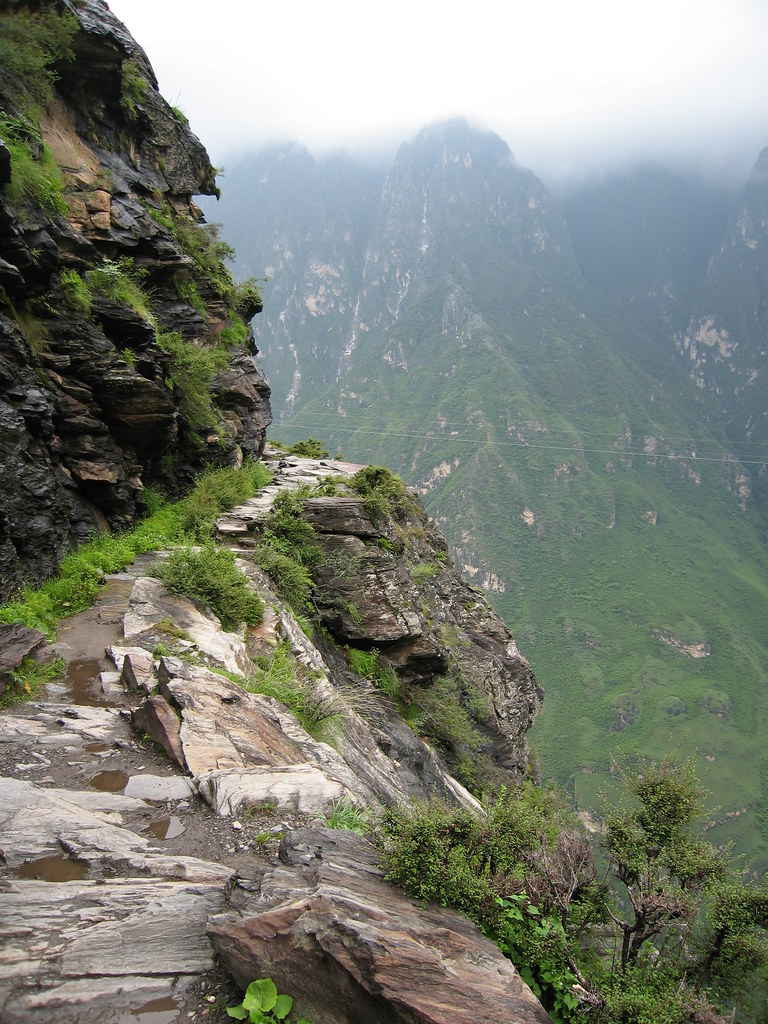
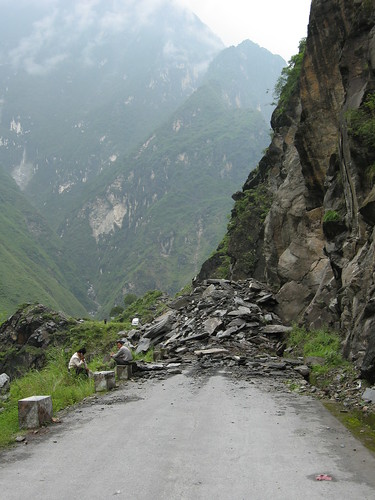
:: Dancing in Zhongdian ::
We found ourselves traveling along the same route as Aussies Blake & Ros and Stu & Jane. After a couple of packs of cards were introduced we settled into a couple of competitive nights of cards interrupted only by last minute dashes down to make the skewer ladies before they packed up for the night. Jane and Stu suggested a day trip of picking a nearby mountain and climbing it with a picnic. The contents of the picnic quickly expanded to included a kilo of the finest yak cheese and a couple of bottles of Yunnan red - that was all the incentive the rest of us needed. The following morning laden down with a massive picnic we marched up the selected mountain and polished the lot off. After a fabulous picnic we made a somewhat giddy decent back into down ... no ordinary hike indeed... positively flashpackery.Our next stop in the weird town of Daocheng, as it's national park Yading is currently closed there is no reason to spend any time in this place; you stop for the night and then escape as quickly as possible the following day.

We arrived in Daocheng after a horrendous day of traveling. Not only did we get a puncture that day but as night fell and we were climbing hairpin bend roads over an extremely high pass (no trees or vegetation to be seen out the window) the engine started making funny noises as the universal joint totally gave up on us. Thankfully we made it to the top and pretty much freewheeled down the other side of the mountain into a town where we were met by a mechanic. After a bit of old school soldering and hammering (using the car headlights as a flashlight) the universal joint was miraculously fixed and we rolled on into the kip that is Daocheng.
:: View Over Litang ::
Our next stop was the wild west cowboy Tibetan town of Tagong located in the middle of the Sichuan rolling grasslands. Tagong is a one street colourful trading town - the local woman wear heavy silver jewelery and weave a red braid and yak bones into their hair. Most of the local men have long flowing hair and stride around in cowboy hats. We stayed in Gayla's Guesthouse a Tibetan home converted into funky accommodations - the dorm rooms were there most ornate one's we've seen to date.
After a couple of one night stops in Danba and Kangding we hopped on a super deluxe bus (unintentionally) and floated into Chengdu city hours ahead of schedule. Luck continued to be on our side when we found out that there were only two tickets left for the train to Lhasa on the 2nd of September. (The Tickets are sourced from the black market, such is the demand...)
The next thing on the agenda is to go and do a big shop for foodstuffs for the train, the Chinese are the masters of individually wrapped snack foods, entire supermarket floors are filled with every type of snack imaginable. There's no excuse for boarding without preserved eggs, vacuum packed skewers, jellies and a carefully chosen range of noodle dishes.
So, that's the saga so far, it's time to say farewell to China and take the a train up to the rooftop of the world, Tibet & Nepal, here we come.
 Read more...
Read more...
China's Wild (Sth) West...

Our first stop was Dali an ancient city that has undergone extensive restoration. Flanked by a mountain, and surrounded by high city walls and a moat this city is a mecca for Chinese tourists. We spent quite a bit of time watching all the ridiculous photo opportunities that people were taking outside the city walls amidst downpours of rain. As a major tourist destination there were no shortage of restaurants to cater for demand. One thing that has shocked us is that since we were here eight months ago the price of meat has risen by a whopping 45%. Luckily we saw this fact on TV otherwise we'd still believe that people were trying to rip us off. Unfortunately we left Dali before realising that one of the most famous "chinglish" signs lived there, it's a famous sign over a squat toilet that simply reads "No shitting in the toilet". Moving north in the full brunt of the region's wet season we reached the picturesque city of Lijiang. Despairingly we reached the labyrinth of the old town as darkness was falling and when there wasn't much room at any of the inns. Arriving under such conditions is always the worst part about backpacking, particularly when the bags are getting heavier and wetter. Adding to the stress were armies of tiny Chinese tourists barging around with umbrellas held at a dangerously eye gouging height - well for me anyhow. Whenever they tried to pass Marcus they bizarrely would attempt to raise their umbrella over and above his! The following morning bathed in sunshine, Lijiang looked a lot more appealing - although the peril of the sun umbrella was still threatening. We managed to find a perfect little traditional Naxi courtyard guesthouse complete with a friendly pregnant owner who when asked when the baby was due replied "it's coming in two days".
The old narrow streets of Lijiang are lined with small waterways and little bridges making it a quirky little place with lots of character. The local ethnic minority in the region is the Naxi people and their Dongba religion and culture, of Tibetan origin, is an important part of the music, paintings and lives of the people. Lijiang is also an extremely popular destination for rich domestic tourists; after dark the bars and restaurants are full of this breed favouring expensive imported Heineken in place of their cheaper local brew. The rowdiness and noise level gradually elevates as rival bars compete in "sing offs" across the canals. Literally one bunch of girls trying to out-sing the other, what's more is that it appears to be the same song that they sing all night, every night.
 Our next stop was a 2 day hike through Tiger Leaping Gorge, allegedly the deepest gorge in the world. Again, it's a heavily visited spot but thankfully the bus tourists are all confined to the bottom of the gorge close to the river (and near the bus parking lot). The hiking trail wanders high up the gorge along a tranquil scenic route far away from the hustle and bustle below. Hiking the gorge is relatively straightforward, you leave any big luggage under lock and key at the start of the hike and take off with a small bag, some water and a map. There are guesthouses dotted along the trail and red arrows mark the way. In total the trek takes about 8 hours. Most people complete it in an easy two day outing leaving lots of time to enjoy the scenery.
Our next stop was a 2 day hike through Tiger Leaping Gorge, allegedly the deepest gorge in the world. Again, it's a heavily visited spot but thankfully the bus tourists are all confined to the bottom of the gorge close to the river (and near the bus parking lot). The hiking trail wanders high up the gorge along a tranquil scenic route far away from the hustle and bustle below. Hiking the gorge is relatively straightforward, you leave any big luggage under lock and key at the start of the hike and take off with a small bag, some water and a map. There are guesthouses dotted along the trail and red arrows mark the way. In total the trek takes about 8 hours. Most people complete it in an easy two day outing leaving lots of time to enjoy the scenery.

:: Dancing in Zhongdian ::
We found ourselves traveling along the same route as Aussies Blake & Ros and Stu & Jane. After a couple of packs of cards were introduced we settled into a couple of competitive nights of cards interrupted only by last minute dashes down to make the skewer ladies before they packed up for the night. Jane and Stu suggested a day trip of picking a nearby mountain and climbing it with a picnic. The contents of the picnic quickly expanded to included a kilo of the finest yak cheese and a couple of bottles of Yunnan red - that was all the incentive the rest of us needed. The following morning laden down with a massive picnic we marched up the selected mountain and polished the lot off. After a fabulous picnic we made a somewhat giddy decent back into down ... no ordinary hike indeed... positively flashpackery.Our next stop in the weird town of Daocheng, as it's national park Yading is currently closed there is no reason to spend any time in this place; you stop for the night and then escape as quickly as possible the following day.

We arrived in Daocheng after a horrendous day of traveling. Not only did we get a puncture that day but as night fell and we were climbing hairpin bend roads over an extremely high pass (no trees or vegetation to be seen out the window) the engine started making funny noises as the universal joint totally gave up on us. Thankfully we made it to the top and pretty much freewheeled down the other side of the mountain into a town where we were met by a mechanic. After a bit of old school soldering and hammering (using the car headlights as a flashlight) the universal joint was miraculously fixed and we rolled on into the kip that is Daocheng.
:: View Over Litang ::
Our next stop was the wild west cowboy Tibetan town of Tagong located in the middle of the Sichuan rolling grasslands. Tagong is a one street colourful trading town - the local woman wear heavy silver jewelery and weave a red braid and yak bones into their hair. Most of the local men have long flowing hair and stride around in cowboy hats. We stayed in Gayla's Guesthouse a Tibetan home converted into funky accommodations - the dorm rooms were there most ornate one's we've seen to date.
After a couple of one night stops in Danba and Kangding we hopped on a super deluxe bus (unintentionally) and floated into Chengdu city hours ahead of schedule. Luck continued to be on our side when we found out that there were only two tickets left for the train to Lhasa on the 2nd of September. (The Tickets are sourced from the black market, such is the demand...)
The next thing on the agenda is to go and do a big shop for foodstuffs for the train, the Chinese are the masters of individually wrapped snack foods, entire supermarket floors are filled with every type of snack imaginable. There's no excuse for boarding without preserved eggs, vacuum packed skewers, jellies and a carefully chosen range of noodle dishes.
So, that's the saga so far, it's time to say farewell to China and take the a train up to the rooftop of the world, Tibet & Nepal, here we come.
 Read more...
Read more...
The Road to Mandalay Part 5: Mandalay
We got chatting to our riders...in between lung fulls of exhaust....and they provided us an interesting insight into their business. It turned out that these guys were trishaw drivers by choice, they had an education, had good English skills and had work experience but with the current state of things they earned more riding than they did teaching or working for the government. To rent their bike cost them 300 KYT per day (~.30c AUD). Their goal was to save and buy the bike (100USD) , which one of the guys recently had achieved. Rent is 4000KYT (4$ AUD) a month for a bamboo hut. These guys worked hard, but with their language skills they were well placed to get work from tourists which hopefully means more income for them.
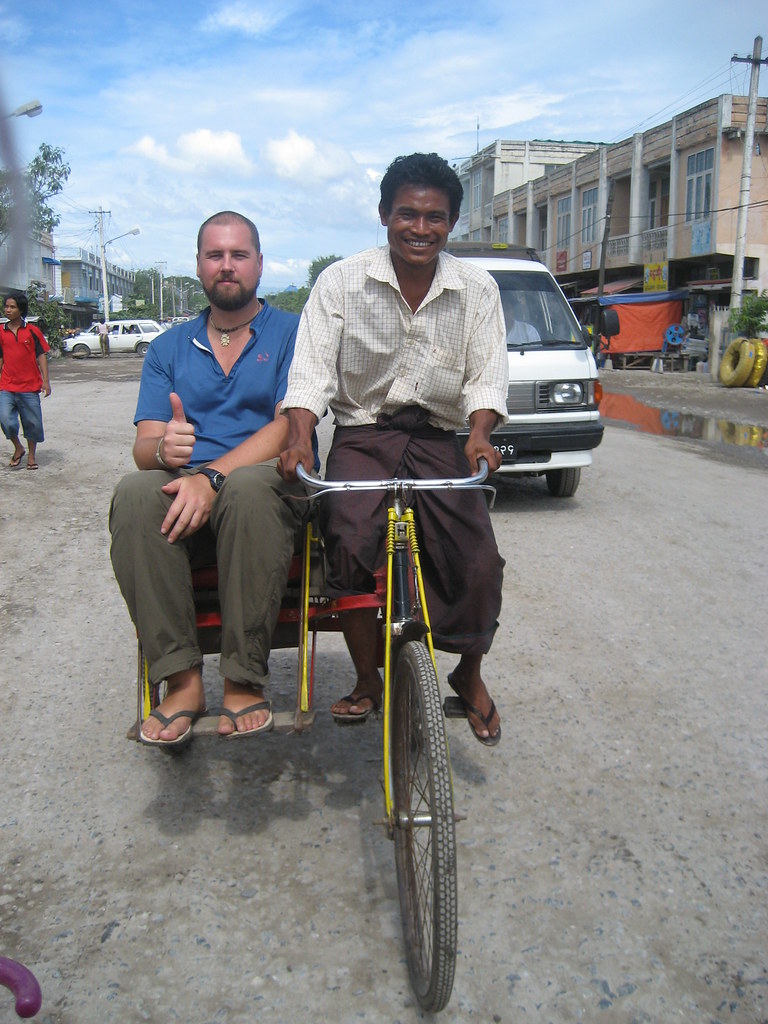
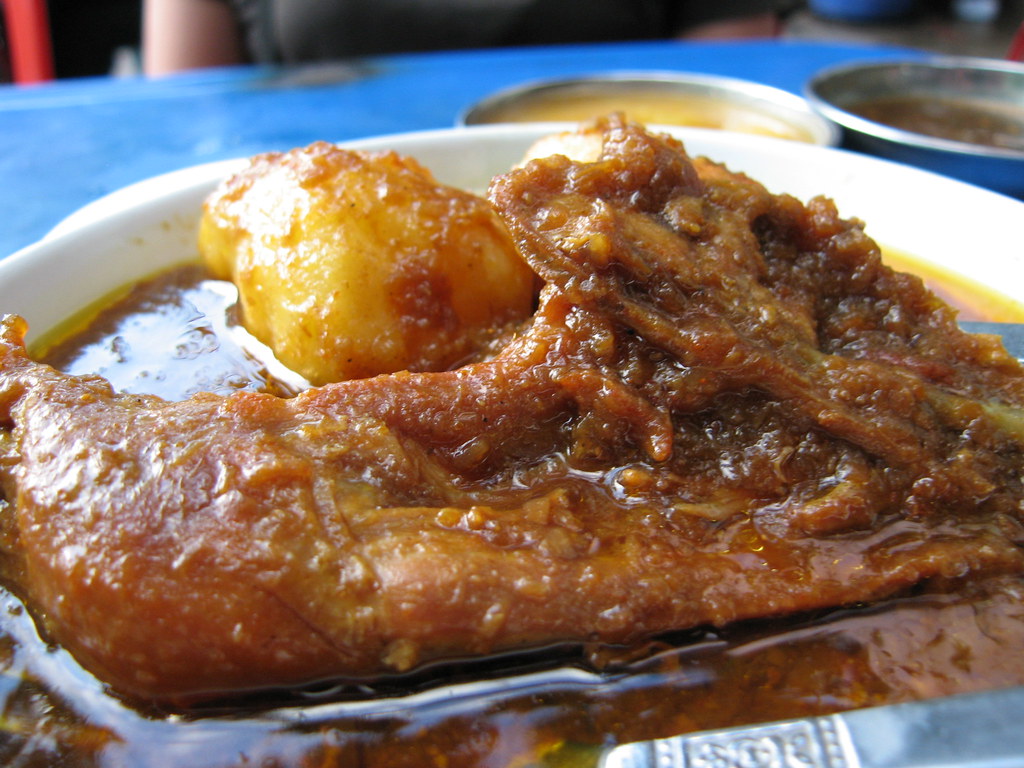
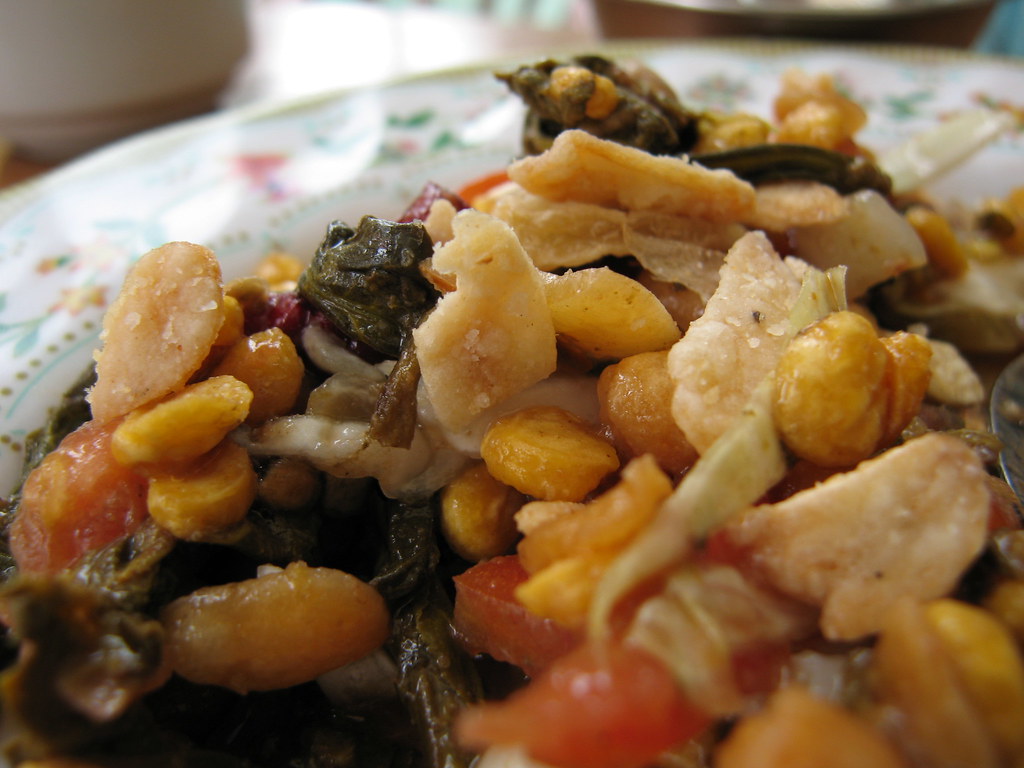
To escape the heat of Mandalay we took a side trip to the hill town of Pyin OO Lwin three hours pickup drive away. This is a charming little town with many imposing colonial buildings and a colourful fleet of horse drawn stagecoaches that provide a taxi service around town. It's like the wild west meeting the cool Mandalay hills. The highlight of our trip up there was finding a great tea shop with an amazing tea leaf salad and crispy naan bread.

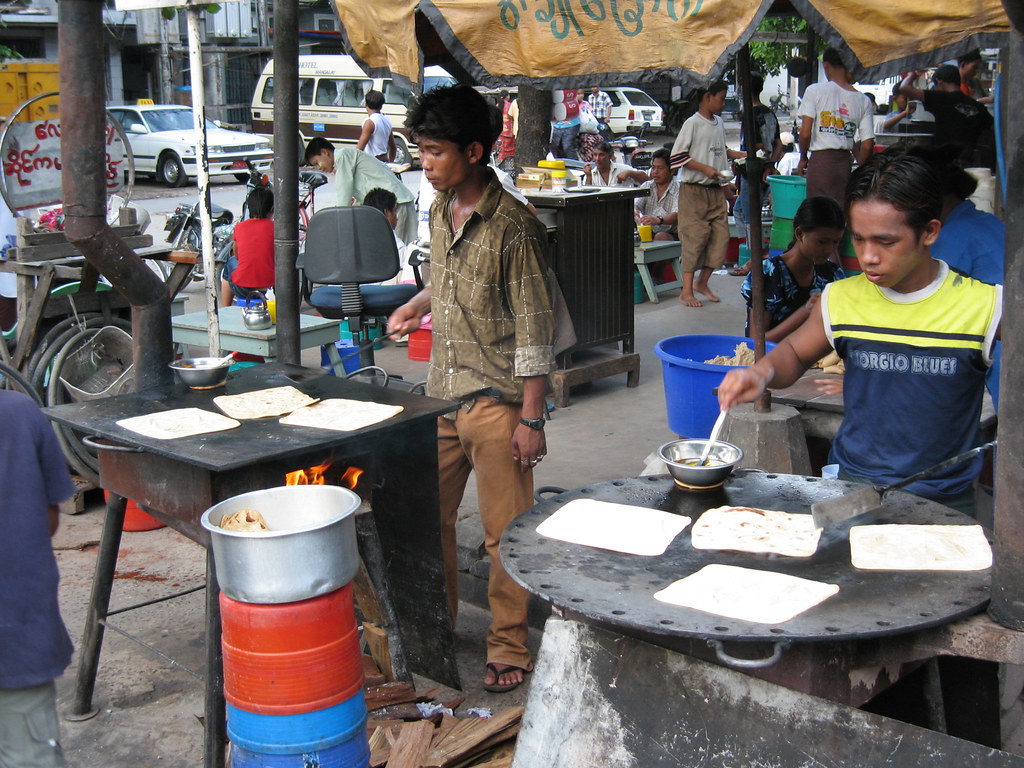
The Road to Mandalay Part 5: Mandalay
We got chatting to our riders...in between lung fulls of exhaust....and they provided us an interesting insight into their business. It turned out that these guys were trishaw drivers by choice, they had an education, had good English skills and had work experience but with the current state of things they earned more riding than they did teaching or working for the government. To rent their bike cost them 300 KYT per day (~.30c AUD). Their goal was to save and buy the bike (100USD) , which one of the guys recently had achieved. Rent is 4000KYT (4$ AUD) a month for a bamboo hut. These guys worked hard, but with their language skills they were well placed to get work from tourists which hopefully means more income for them.



To escape the heat of Mandalay we took a side trip to the hill town of Pyin OO Lwin three hours pickup drive away. This is a charming little town with many imposing colonial buildings and a colourful fleet of horse drawn stagecoaches that provide a taxi service around town. It's like the wild west meeting the cool Mandalay hills. The highlight of our trip up there was finding a great tea shop with an amazing tea leaf salad and crispy naan bread.


Tuesday, August 14, 2007
The Road to Mandalay Part 4 : Bagan

Bagan entered the golden age in 1057 AD when King Anawrahta conquered the Mon capital of Thaton, and brought back to his capital the Tripitaka Pali scriptures, a large number of Buddhist monks and artists and craftsmen of every description. The result was the transformation of Bagan into a religious and cultural centre. In the 12th and 13th centuries, Bagan became a truly cosmopolitan centre of Buddhist studies, attracting monks and students from as far as India, Sri Lanka as well as the Thai and Khmer kingdoms. It was during these two centuries of extraordinary architectural and artistic activity that city and its surrounds were covered with over 13,000 splendid monuments of every shape and size, the inner walls of most of which are decorated with incredible frescoes.
Today some 2,224 monuments from the original 4,446 that existed at the end of the 13th century still stand in a vast open plain covering 16 square miles. From the top of most of the temples you can look out across the dusty plain and see and endless uninterrupted view of literally thousands of temples.

Bagan is divided into three sections, Old Bagan where the ruins are co-located with a couple of swanky hotels, New Bagan where all the locals were "relocated" to by the government in 1990 (from Old Bagan) and Nyuang-U where most of the tourists hang out and every second restaurant offers "pizza and pasta". Staying in Nyuang-U you quickly find out there are two ways to see the temples; you can hire a horse and cart or take a bicycle, we chose the route of most independence and found ourselves on a three day very hot bike expedition around miles of sandy paths that meander around the thousands of temples. There are so many temples that it's impossible to see all of them all. Our route didn't always go to plan and there was lots of pushing the bikes through ploughed fields to a pagoda where we couldn't find the road. Our most annoying experience was where the map indicated that there was a road straight through a golf course and out the other side but a security guy on the gate refused to let us cycle through whilst droves of locals were whizzing along the route. Yes.... I did say golf course... there are even a couple of stupas in the middle of it all... there wasn't a sniff of a golfer the day we didn't pass through.

There are some highlight pagodas which see the most tourists every day. You can easily tell how popular a place is by looking to see how many hawkers are selling laquerware and sand paintings outside. We preferred some off the beaten track temples where we could usually get a few minutes of solitude up the top admiring the view before we were tracked down by someone selling their wares. Unfortunately there are a large number of really young kids selling post cards and trying to collect and exchange foreign currency from tourists. The hassling around the area is very persistent and can become very annoying. The Burmese phrases "I'm not buying" and "I don't want" came in very handy when they didn't fall on deaf ears.
Entrance into the archaeological area is totally unrestricted, foreigners purchase their $10 US dollar entrance ticket at the airport or on the bus on the way to Bagan this then entitles you to unlimited access for an unlimited amount of days to the area. It's largely accepted that most of the entrance fee lines the governments coffers with only a small portion actually going to the preservation and protection of the Bagan area. Sadly UNESO failed to designate Bagan has a world heritage site and has pulled out of the country after allegedly finding it impossible to work with the Myanmar government. It's also reported that the military junta has haphazardly restored ancient stupas, temples and buildings, ignoring original architectural styles and using modern materials that bear no resemblance to the original designs. Interestingly The Plain of Bagan is a living collection, new stupas are being built by rich families, this is a really great thing, its a growing spectacle.
Read more...
The Road to Mandalay Part 4 : Bagan

Bagan entered the golden age in 1057 AD when King Anawrahta conquered the Mon capital of Thaton, and brought back to his capital the Tripitaka Pali scriptures, a large number of Buddhist monks and artists and craftsmen of every description. The result was the transformation of Bagan into a religious and cultural centre. In the 12th and 13th centuries, Bagan became a truly cosmopolitan centre of Buddhist studies, attracting monks and students from as far as India, Sri Lanka as well as the Thai and Khmer kingdoms. It was during these two centuries of extraordinary architectural and artistic activity that city and its surrounds were covered with over 13,000 splendid monuments of every shape and size, the inner walls of most of which are decorated with incredible frescoes.
Today some 2,224 monuments from the original 4,446 that existed at the end of the 13th century still stand in a vast open plain covering 16 square miles. From the top of most of the temples you can look out across the dusty plain and see and endless uninterrupted view of literally thousands of temples.

Bagan is divided into three sections, Old Bagan where the ruins are co-located with a couple of swanky hotels, New Bagan where all the locals were "relocated" to by the government in 1990 (from Old Bagan) and Nyuang-U where most of the tourists hang out and every second restaurant offers "pizza and pasta". Staying in Nyuang-U you quickly find out there are two ways to see the temples; you can hire a horse and cart or take a bicycle, we chose the route of most independence and found ourselves on a three day very hot bike expedition around miles of sandy paths that meander around the thousands of temples. There are so many temples that it's impossible to see all of them all. Our route didn't always go to plan and there was lots of pushing the bikes through ploughed fields to a pagoda where we couldn't find the road. Our most annoying experience was where the map indicated that there was a road straight through a golf course and out the other side but a security guy on the gate refused to let us cycle through whilst droves of locals were whizzing along the route. Yes.... I did say golf course... there are even a couple of stupas in the middle of it all... there wasn't a sniff of a golfer the day we didn't pass through.

There are some highlight pagodas which see the most tourists every day. You can easily tell how popular a place is by looking to see how many hawkers are selling laquerware and sand paintings outside. We preferred some off the beaten track temples where we could usually get a few minutes of solitude up the top admiring the view before we were tracked down by someone selling their wares. Unfortunately there are a large number of really young kids selling post cards and trying to collect and exchange foreign currency from tourists. The hassling around the area is very persistent and can become very annoying. The Burmese phrases "I'm not buying" and "I don't want" came in very handy when they didn't fall on deaf ears.
Entrance into the archaeological area is totally unrestricted, foreigners purchase their $10 US dollar entrance ticket at the airport or on the bus on the way to Bagan this then entitles you to unlimited access for an unlimited amount of days to the area. It's largely accepted that most of the entrance fee lines the governments coffers with only a small portion actually going to the preservation and protection of the Bagan area. Sadly UNESO failed to designate Bagan has a world heritage site and has pulled out of the country after allegedly finding it impossible to work with the Myanmar government. It's also reported that the military junta has haphazardly restored ancient stupas, temples and buildings, ignoring original architectural styles and using modern materials that bear no resemblance to the original designs. Interestingly The Plain of Bagan is a living collection, new stupas are being built by rich families, this is a really great thing, its a growing spectacle.
Read more...
Monday, August 13, 2007
The Road to Mandalay Part 3 : Kalaw

After a few hours hiking through the tea and orange tree plantations we stopped for lunch in a house of a local village man for lunch. Our host was bent over a manuscript carefully transcribing lines from an old text for the local monastery, he is regularly commissioned to reproduce texts of the story of his tribe. He is the (only) writer in the Paulong village. He passed on the skills of writing the Paulong language to his son who is now a monk in the village. The book he was transcribing was of Buddhas life, from a copy he wrote a number of years ago. Traditionally the books are made from a large number of paper sheets glued together. The ink is made from tea leaves ... mix it with the pigs gallbladder. It was a few hours of slipping and sliding in the mud later when we dropped back into Kalaw town. After a couple of refreshing Myanmar Beers we trudged back to the guesthouse for welcome hot shower.


The Road to Mandalay Part 3 : Kalaw

After a few hours hiking through the tea and orange tree plantations we stopped for lunch in a house of a local village man for lunch. Our host was bent over a manuscript carefully transcribing lines from an old text for the local monastery, he is regularly commissioned to reproduce texts of the story of his tribe. He is the (only) writer in the Paulong village. He passed on the skills of writing the Paulong language to his son who is now a monk in the village. The book he was transcribing was of Buddhas life, from a copy he wrote a number of years ago. Traditionally the books are made from a large number of paper sheets glued together. The ink is made from tea leaves ... mix it with the pigs gallbladder. It was a few hours of slipping and sliding in the mud later when we dropped back into Kalaw town. After a couple of refreshing Myanmar Beers we trudged back to the guesthouse for welcome hot shower.


Thursday, August 09, 2007
The Road to Mandalay Part 2
A long (19 Hours) overnight bus journey covering 660 Km brought us to Lake Inle, a freshwater lake in the mountains of Myanmar's Shan state. The lake shores are home to 70,000 people who live in wood and woven bamboo huts on stilts and live simple lives as farmers and fishermen. The dominant ethnic group in this area is the Intha people who have developed a distinctive one foot rowing style. Standing on the stern of the boat with one leg the men wrap their other leg around the oar and power themselves along using just their leg. The one advantage this weird style gives the men is better visibility over the reeds ahead.

We used the village as Nyaungshwe as a base to explore the area. The village is located about 5 miles upstream of the lake. One thing we immediately noticed in the village was that there were crates of tomatoes being loaded up into trucks everywhere. We took a walk around the village and came upon warehouse after warehouse full of people sorting hundreds of thousands of tomatoes into different boxes. A day trip out on the lake revealed the source of the crop. Using seaweed from the lake, farmers have constructed rows and rows of long floating saturated platforms; so-called floating gardens covering kilometres of the lake. According to the season crops such as tomatoes, peppers, sunflowers etc are sown by the farmers who access the floating gardens in little wooden boats. While we were there the local ladies were out in force in their little boats picking the ripe tomatoes as far as the eye could see on the lake there were floating tomato plants laden with fruits...... important learning point .... from what we've seen it's not possible to over water tomatoes!
:: Harvesting on the lake ::

An obvious left over from the colonial days is the practice of frequenting tea houses. Tea, cakes and savoury snacks are offered either on curbside plastic (kindergarten sized) tables, or in minimalist shops (concrete floor and adult sized plastic tables). Busy from breakfast until dinner time, men, women and families drop in for a hot drop and a nibble. At the other end of the spectrum, beer stations are the Myanmar versions of pubs. Normally all-male, concrete floored and equipped with 1 beer tap (serving whichever brand the beer station is affiliated to) the really interesting thing about them is that most people there are not drinking beer. Spirits in Myanmar are stupidly cheap. $2 AUD (1.2 EUR) will get you a 700ml bottle of decent whisky (even cheaper for Rum or white spirits). For the price of a beer you can get a quarter bottle of spirit so most guys opt for the whisky. They buy a bottle and sit down with water to finish it (half or qtr bottles mostly) or they get a slug put into their mug of draft beer. Apparently these boozers are a fairly new arrival in Myanmar, they seemed to have hit a sweet spot as they were to be found in most of the towns we visited.
From our chats with locals, another interesting point kept coming up. The governments intervention in communications. Personal incoming and outgoing mail is routinely read. There is only one mobile phone company - Government owned, so thats covered (and a SIM costs $2000 USD) and only one ISP, so they watch your internet movements as well. One example given to us was that email sent internally takes between 1 and 2 days to arrive (read make it through the government censors).
I think this photo I took at the Mandalay airport pretty much sums it up.



